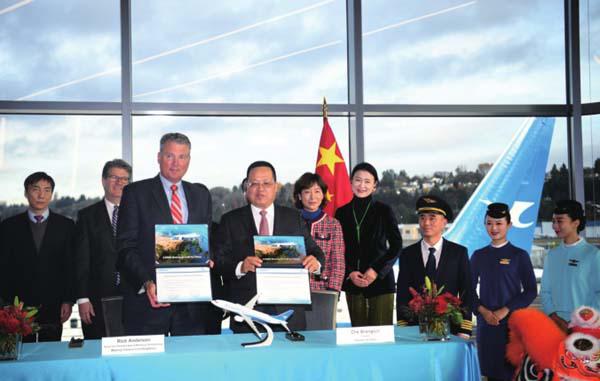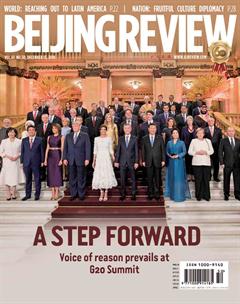A TEST OF TIME
By An Gang
When the working dinner between Chinese President Xi Jinping and U.S. President Donald Trump ended after the G20 Summit in Buenos Aires on December 1, Chinese State Councilor and Foreign Minister Wang Yi told the media that the meeting has “chartered the course for China-U.S. relations,” with the two presidents reaching an important common understanding.
The two sides decided to avoid escalation of trade-restrictive measures, open their market to each other and resolve the rea- sonable concerns of the U.S. in the process of Chinas new round of reform and opening up. The work teams of the two sides will follow the consensus and step up negotiations to remove additional tariffs, so as to reach a specifi c agreement with mutual benefi t and win-win results at an early date.
Blow to global growth
For most of 2018, the intensifying trade frictions between China and the United States became a world topic and the core agenda of the bilateral relationship, seriously discouraging global economic recovery and growth. In June, Trump approved a 25-percent tariff on $50 billion worth of goods imported from China; in September he announced a 10-percent tariff on $200 billion worth of Chinese goods and this was expected to increase to 25 percent on January 1, 2019. If China had retaliated, tariffs were to have been imposed on $267 billion of additional goods.
Calling the action “trade unilateralism, protectionism and bullying,” China responded with 5 to 25 percent tariffs on $60 billion worth of U.S. products. These covered more than 5,000 categories, reducing imports of farm produce, daily commodities and chemical and medical products from the U.S.
As the pressure of the Chinese economic slowdown intensifies and the U.S. economy shows increasing signs of prerecession, such fi erce trade frictions will, if they continue, lead to damage to both and even other countries. The Wall Street as well as the U.S. industrial and agricultural circles have been lobbying to stop the trade war.
This confl ict unfortunately occurred in the year of U.S. mid-term elections, with domestic political factors deeply involved. The issue is not confined to the trade sector, but will affect the two countriesstrategic judgments of each other, with the negative influence spreading to political, military, security and cultural fields. China perceives the U.S. acceleration of the adjustment of its strategy against China as aiming to hold back the rise of China; the U.S., on the other hand, is accusing China of intervening in its domestic affairs.
In his speeches at U.S. think tank Hudson Institute on October 4 and the Asia-Pacific Economic Cooperation CEO Summit on November 7, U.S. Vice President Mike Pence alleged China was using a variety o f tools to advance its infl uence in the United States and also obtain American intellectual property, further intensifying bilateral divergence.
A changed relationship
A combination of issues concerning trade, Taiwan, the South China Sea and human rights has brought Sino-U.S. relations to an all-time low since the two countries established diplomatic ties in 1979. In China, the focal points of discussions in strategic circles for some time have been how China should cope with a possible change in U.S. policy against it and how China should readjust its reform and development strategies. Such discussions still continue, with no conclusion reached.
Despite the meeting in Buenos Aires, many scholars and media professionals from both China and the United States believe the relationship between the two countries will never revert to what it was in the past. The “new normal” including long trade frictions may become a reality that both parties and even the international community have to accept. Chinese scholars still doubt whether Washington, controlled by hawks, is trustworthy. They are also concerned that the consensus reached on trade is temporary. Its results will depend on the negotiations in the next three months, so there may be changes during this period. If the negotiations do not go well, the “ceasefire” in the trade war is likely to see more fierce trade frictions.
Nevertheless, both China and the United States clearly recognize that given the huge sizes of their economies and their deeply interwoven interests, any changes in their relations will have a profound influence. Even if there are irreconcilable structural conflicts, stronger and wider competition, and unavoidable “disconnection” in some fields, there should not be all-round confrontation and open conflicts. The two countries must have professional management of disputes, and continue their cooperation wherever possible.
At Buenos Aires, China repeated its position that “common interests outweigh the differences and the need for cooperation is greater than frictions.” The two sides agreed to take proactive steps to strengthen cooperation in law enforcement and drug control, including control of fentanyllike substances.
As Xi said, as two major countries, China and the United States jointly shoulder more and more important responsibilities in promoting world peace and prosperity, and cooperation is the best choice for both. The two heads of state agreed that China-U.S. relations must be and will be improved, and consented to promote bilateral relations based on coordination, cooperation and stability.
This is not merely a good vision, but also a realistic choice. However, given the uncertainties, the results have yet to be tested by time.

